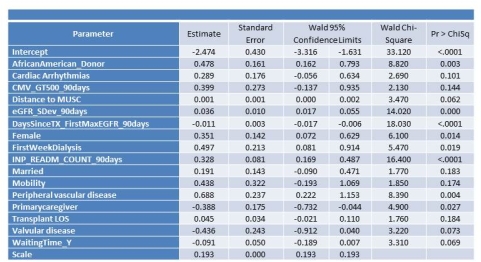Predictors of eGFR Slope at One Year in Kidney Transplants – A Big Data Approach.
MUSC, Charleston.
Meeting: 2016 American Transplant Congress
Abstract number: 314
Keywords: Graft function, Kidney transplantation, Methodology, Monitoring
Session Information
Session Name: Concurrent Session: Kidney Transplant Recipient: Long Term Outcomes Session I
Session Type: Concurrent Session
Date: Monday, June 13, 2016
Session Time: 4:30pm-6:00pm
 Presentation Time: 5:06pm-5:18pm
Presentation Time: 5:06pm-5:18pm
Location: Veterans Auditorium
Background: Estimated glomerular filtration rate (eGFR), a predictor of graft loss (GL) in kidney transplantation could inform intervention. National data yield eGFRs at fixed time points ignoring eGFR trajectory, limiting predictive efficacy. The aim of this inquiry was to determine factors strongly associated with eGFR trajectory.
Methods: Through a quality initiative, we developed a predictive risk model of eGFR trajectory, using baseline and follow up data (0-90-days post-transplant (post-tx)), both structured and unstructured. We included adult solitary kidney transplant recipients transplanted between 2007-15. We excluded patients with GL 0-7 days post-transplant or with no GL recorded nor other data during the 1st yr post-tx, or who died within 90 days. Detailed structured data were directly applied from electronic records (EHR, UNOS, Txp database (Velos)) and Natural Language Processing (IBM Watson) was applied to unstructured text fields to calculate Banff scores and select vitals. eGFR trajectory was defined as the absolute value of the slope from maximum eGFR to eGFR at day 365. SAS 9.3 was used for analysis. Backward selection was used at the 20% level for variable selection, and statistical significance set at the 5% level.
Results: 1,179 patients were included in this analysis; 40% were female, 53% African American, with a mean age of 52 years. Variables significantly associated with increased eGFR trajectory included days to maximum eGFR, and whether a patient had a primary care giver at the time of transplant. Variables significantly associated with decreased eGFR trajectory included African American donor race, eGFR standard deviation over the 1st 90 Days, female gender, DGF, inpatient readmissions following transplant, and peripheral vascular disease. The predictive model demonstrated strong goodness of fit. 
Conclusion: eGFR trajectory is predicted by several immutable factors, such as donor quality, comorbidities, gender and race, as well as clinically actionable factors, such as eGFR variation, post-transplant cardiac events, readmissions and having good caregiver support. Inclusion of eGFR trajectory in predictive models could help guide interventions to optimize outcomes.
CITATION INFORMATION: Zhang J, Su Z, Taber D, Marsden J, Moran W, Mauldin P, Srinivas T. Predictors of eGFR Slope at One Year in Kidney Transplants – A Big Data Approach. Am J Transplant. 2016;16 (suppl 3).
To cite this abstract in AMA style:
Zhang J, Su Z, Taber D, Marsden J, Moran W, Mauldin P, Srinivas T. Predictors of eGFR Slope at One Year in Kidney Transplants – A Big Data Approach. [abstract]. Am J Transplant. 2016; 16 (suppl 3). https://atcmeetingabstracts.com/abstract/predictors-of-egfr-slope-at-one-year-in-kidney-transplants-a-big-data-approach/. Accessed December 22, 2025.« Back to 2016 American Transplant Congress
